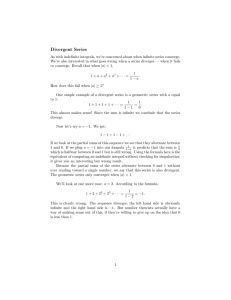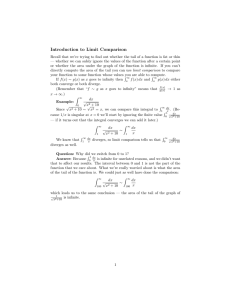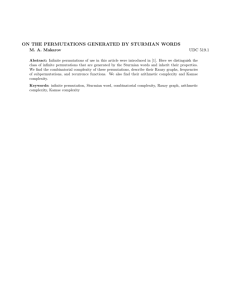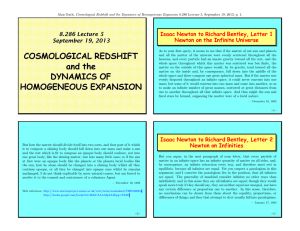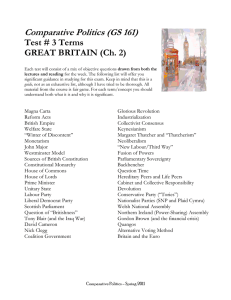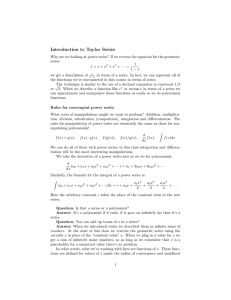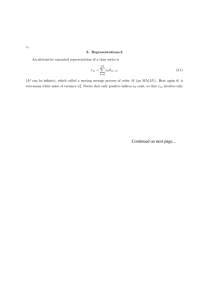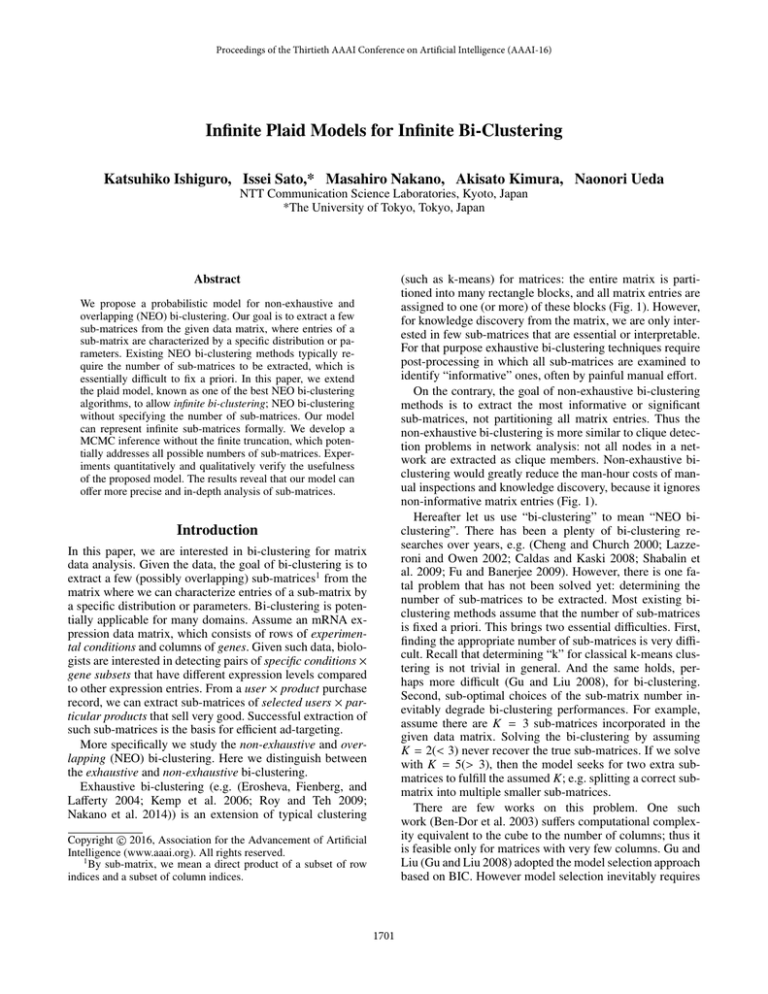
Proceedings of the Thirtieth AAAI Conference on Artificial Intelligence (AAAI-16)
Infinite Plaid Models for Infinite Bi-Clustering
Katsuhiko Ishiguro, Issei Sato,* Masahiro Nakano, Akisato Kimura, Naonori Ueda
NTT Communication Science Laboratories, Kyoto, Japan
*The University of Tokyo, Tokyo, Japan
(such as k-means) for matrices: the entire matrix is partitioned into many rectangle blocks, and all matrix entries are
assigned to one (or more) of these blocks (Fig. 1). However,
for knowledge discovery from the matrix, we are only interested in few sub-matrices that are essential or interpretable.
For that purpose exhaustive bi-clustering techniques require
post-processing in which all sub-matrices are examined to
identify “informative” ones, often by painful manual effort.
On the contrary, the goal of non-exhaustive bi-clustering
methods is to extract the most informative or significant
sub-matrices, not partitioning all matrix entries. Thus the
non-exhaustive bi-clustering is more similar to clique detection problems in network analysis: not all nodes in a network are extracted as clique members. Non-exhaustive biclustering would greatly reduce the man-hour costs of manual inspections and knowledge discovery, because it ignores
non-informative matrix entries (Fig. 1).
Hereafter let us use “bi-clustering” to mean “NEO biclustering”. There has been a plenty of bi-clustering researches over years, e.g. (Cheng and Church 2000; Lazzeroni and Owen 2002; Caldas and Kaski 2008; Shabalin et
al. 2009; Fu and Banerjee 2009). However, there is one fatal problem that has not been solved yet: determining the
number of sub-matrices to be extracted. Most existing biclustering methods assume that the number of sub-matrices
is fixed a priori. This brings two essential difficulties. First,
finding the appropriate number of sub-matrices is very difficult. Recall that determining “k” for classical k-means clustering is not trivial in general. And the same holds, perhaps more difficult (Gu and Liu 2008), for bi-clustering.
Second, sub-optimal choices of the sub-matrix number inevitably degrade bi-clustering performances. For example,
assume there are K = 3 sub-matrices incorporated in the
given data matrix. Solving the bi-clustering by assuming
K = 2(< 3) never recover the true sub-matrices. If we solve
with K = 5(> 3), then the model seeks for two extra submatrices to fulfill the assumed K; e.g. splitting a correct submatrix into multiple smaller sub-matrices.
There are few works on this problem. One such
work (Ben-Dor et al. 2003) suffers computational complexity equivalent to the cube to the number of columns; thus it
is feasible only for matrices with very few columns. Gu and
Liu (Gu and Liu 2008) adopted the model selection approach
based on BIC. However model selection inevitably requires
Abstract
We propose a probabilistic model for non-exhaustive and
overlapping (NEO) bi-clustering. Our goal is to extract a few
sub-matrices from the given data matrix, where entries of a
sub-matrix are characterized by a specific distribution or parameters. Existing NEO bi-clustering methods typically require the number of sub-matrices to be extracted, which is
essentially difficult to fix a priori. In this paper, we extend
the plaid model, known as one of the best NEO bi-clustering
algorithms, to allow infinite bi-clustering; NEO bi-clustering
without specifying the number of sub-matrices. Our model
can represent infinite sub-matrices formally. We develop a
MCMC inference without the finite truncation, which potentially addresses all possible numbers of sub-matrices. Experiments quantitatively and qualitatively verify the usefulness
of the proposed model. The results reveal that our model can
offer more precise and in-depth analysis of sub-matrices.
Introduction
In this paper, we are interested in bi-clustering for matrix
data analysis. Given the data, the goal of bi-clustering is to
extract a few (possibly overlapping) sub-matrices1 from the
matrix where we can characterize entries of a sub-matrix by
a specific distribution or parameters. Bi-clustering is potentially applicable for many domains. Assume an mRNA expression data matrix, which consists of rows of experimental conditions and columns of genes. Given such data, biologists are interested in detecting pairs of specific conditions ×
gene subsets that have different expression levels compared
to other expression entries. From a user × product purchase
record, we can extract sub-matrices of selected users × particular products that sell very good. Successful extraction of
such sub-matrices is the basis for efficient ad-targeting.
More specifically we study the non-exhaustive and overlapping (NEO) bi-clustering. Here we distinguish between
the exhaustive and non-exhaustive bi-clustering.
Exhaustive bi-clustering (e.g. (Erosheva, Fienberg, and
Lafferty 2004; Kemp et al. 2006; Roy and Teh 2009;
Nakano et al. 2014)) is an extension of typical clustering
c 2016, Association for the Advancement of Artificial
Copyright Intelligence (www.aaai.org). All rights reserved.
1
By sub-matrix, we mean a direct product of a subset of row
indices and a subset of column indices.
1701
Background
Data matrix.
Baseline: (simplified) Bayesian Plaid model
Exhaustive Bi-clustering
Bi-clustering has been studied intensively for years. A seminal paper (Cheng and Church 2000) has applied the biclustering technique for the analysis of gene-expression
data. After that, many works have been developed (e.g. (Shabalin et al. 2009; Fu and Banerjee 2009)). Among them, the
Plaid model (Lazzeroni and Owen 2002) is recognized as
one of the best bi-clustering methods in several review studies (Eren et al. 2013; Oghabian et al. 2014). Bayesian models of the plaid model have been also proposed and reported
effective (Gu and Liu 2008; Caldas and Kaski 2008).
We adopted a simplified version of Bayesian Plaid models (Caldas and Kaski 2008) as the baseline. The observed
data is a matrix of N1 × N2 continuous values, and K is the
number of sub-matrices to model interesting parts. We define the simplified Bayesian Plaid model as follows:
λ2,k ∼ Beta aλ2 , bλ2 ,
(1)
λ1,k ∼ Beta aλ1 , bλ1
z1,i,k ∼ Bernoulli λ1,k , z2, j,k ∼ Bernoulli λ2,k ,
(2)
θ
θ −1
φ
φ −1
θk ∼ Normal μ , (τ )
, φ ∼ Normal μ , (τ )
, (3)
⎛
⎞
⎜⎜
⎟⎟
z1,i,k z2, j,k θk , (τ0 )−1 ⎟⎟⎟⎠ .
(4)
xi, j ∼ Normal ⎜⎜⎜⎝φ +
Partitions the entire matrix into many blocks.
Post-processing:
manually inspect all blocks
:-(
Non-exhaustive and Overlapping (NEO) Bi-clustering
Extracts only “possibly interesting” sub-matrices:
sharing coherent characteristics.
Post-processing:
only a limited number of sub-matrices!
:-)
Reduce man-hour cost!
Our proposal; Infinite Bi-clustering
NEO Bi-clustering with any number of sub-matrices.
Infer the number of hidden sub-matrices automatically.
Figure 1: Exhaustive bi-clustering VS. NEO bi-clustering.
We offer the infinite bi-clustering: NEO bi-clustering without knowing the exact number of distinctive sub-matrices.
Row and column indices are not consecutive: thus we do not
extract consecutive rectangles, but direct products of subsets
of rows and columns.
k
In the above equations, k ∈ {1, . . . , K} denotes sub-matrices,
i ∈ {1, . . . , N1 } and j ∈ {1, . . . , N2 } denote objects in the first
(row) and the second (column) domains, respectively. λ1,k
and λ2,k (Eq. (1)) are the probabilities of assigning an object
to the kth sub-matrix in the first and the second domain. z1,i,k
and z2, j,k in Eq. (2) represent the sub-matrix (factor) memberships. If z1,i,k = 1(0) then the ith object of the first domain is (not) a member of the kth sub-matrix, and similar
for z2, j,k . θk and φ in Eq. (3) are the mean parameters for the
kth sub-matrix and the “background” factor. Eq. (4) combines these to generate an observation. Note that this observation process is simplified from the original Plaid models.
Throughout the paper, however, we technically focus on the
modeling of Z thus we employ this simplified model.
As stated, existing bi-clustering methods including the
Bayesian Plaid model require us to fix the number of submatrices, K, beforehand. It is very possible to choose a suboptimal K in practice since it is innately difficult to find the
best K by hand.
multiple inference trials for different choices of model complexities (the number of sub-matrices, K). This consumes a
lot of computation and time resources.
The main contribution of this paper is to propose a probabilistic model that allows infinite bi-clustering; NEO biclustering without specifying the number of sub-matrices.
The proposed model is based on the plaid models (Lazzeroni and Owen 2002), which are known to be one of the
best bi-clustering methods (Eren et al. 2013; Oghabian et
al. 2014). The proposed Infinite Plaid models introduce a
simple extension of the Indian Buffet Process (Griffiths and
Ghahramani 2011) and can formulate bi-clustering patterns
with infinitely many sub-matrices. We develop a MCMC inference that allows us to infer the appropriate number of
sub-matrices for the given data automatically. The inference
does not require the finite approximation of typical variational methods. Thus it can potentially address all possible
numbers of sub-matrices, unlike the existing variational inference method for similar prior model (Ross et al. 2014).
Experiment results show that the proposed model quantitatively outperforms the baseline finite bi-clustering method
both for synthetic data and for real-world sparse datasets.
We also qualitatively examine the extracted sub-matrices,
and confirm that the Infinite Plaid models can offer in-depth
sub-matrix analysis for several real-world datasets.
Indian Buffet Process (IBP)
Many researchers have studied sophisticated techniques for
exhaustive bi-clustering. Especially, the Bayesian Nonparametrics (BNP) becomes a standard tool for the problem
of an unknown number of sub-matrices in exhaustive biclustering (Kemp et al. 2006; Roy and Teh 2009; Nakano
et al. 2014; Zhou et al. 2012; Ishiguro, Ueda, and Sawada
2012). Thus it is reasonable to consider the BNP approach
for the (NEO) bi-clustering.
For that purpose, we would first consider an IBP (Griffiths and Ghahramani 2011), a BNP model for binary factor matrices. Assume the following Beta-Bernoulli process
for N collections of K = ∞ feature factors F = {Fi }i=1,...,N :
1702
B = λ1,k , λ2,k , θk , where λ1,k , λ2,k ∈ [0, 1] are the probability of activating a sub-matrix (factor) k in the 1st domain and
the 2nd domain, respectively, and θk is a parameter drawn
from the base measure B0 . Given B, we generate feature
factors for 2-domain indices (i,j): F(i, j) = ∞
k=1 z1,i,k z2, j,k δθk
where two binary variables z1,i,k and z2, j,k represent submatrix(factor) responses.
More precisely, TIBP is defined as a generative process of
such z1,i,k and z2, j,k that extends IBP:
B ∼ BP (α, B0 ), Fi ∼ BerP (B). BP (α, B0 ) is a Beta process with a concentration
parameter α and a base mea
sure B0 . B = ∞
λ
δ
is
a collection of infinite pairs of
k
θ
k
k=0
(λk , θk ) , λk ∈ [0, 1] , θk ∈ Ω. Fi is sampled from the Bernoulli
process (BerP) as Fi = ∞
k=0 zi,k δθk using a binary variable
zi,k ∈ {0, 1}. IBP is defined as a generative process of zi,k :
vl ∼ Beta (α, 1) , λk =
k
vl , zi,k ∼ Bernoulli (λk ) .
l=1
Z = {zi,k } acts like an infinite-K extension of Z 1 or Z 2 in
Eq. (2). Assume that we observed N objects, and an object i
may involve K = ∞ clusters. Then zi,k serves as an membership indicator of the object i to a cluster k.
v1,l ∼ Beta (α1 , 1) , λ1,k =
k
v1,l , z1,i,k ∼ Bernoulli λ1,k ,
l=1
v2,l ∼ Beta (α2 , 1) , λ2,k =
Proposed model
k
v2,l , z2, j,k ∼ Bernoulli λ2,k .
l=1
Unfortunately, a vanilla IBP cannot achieve the infinite biclustering. This is because infinite bi-clustering requires to
associate a sub-matrix parameter θk with two λs, which correspond to two binary variables z1,i,k , z2, j,k (Eqs.(1,2)). However, the IBP ties the parameter θk with only one parameter
as it is built on the pairs of (λk , θk ) in BP.
For example, (Miller, Griffiths, and Jordan 2009) proposed to employ an IBP to factorize a square matrix. This
model and its followers (Palla, Knowles, and Ghahramani
2012; Kim and Leskovec 2013), however, cannot perform
bi-clustering on non-square matrix data, such as user × item
matrix. (Whang, Rai, and Dhillon 2013) employed a product
of independent IBPs to over-decompose a matrix into submatrices, and associated binary variables over sub-matrices
to choose “extract” or “not-extract”. This is not yet optimal
because this model explicitly models the not-extract submatrices, results in unnecessary model complications.
Repeating for all (i,j), we obtain Z 1 = {z1,i,k } ∈ {0, 1}N1 ×∞
and Z 2 = {z2, j,k } ∈ {0, 1}N2 ×∞ . In shorthand we write:
Z 1 , Z 2 | α1 , α2 , ∼ TIBP (α1 , α2 ). Because of the triplets, a
parameter atom θk and the corresponding index k are associated between Z 1 and Z 2 for k ∈ {1, 2, . . . , ∞}. Therefore
the binary matrices generated from TIBP can serve as valid
membership variables for infinite bi-clustering.
TIBP is a generic BNP prior related to the marked Beta
process (Zhou et al. 2012). It would be applicable for many
other problems, not limited to the infinite bi-clustering. For
example, (Ross et al. 2014) employed a similar infinite biclustering prior for a mixture of Gaussian processes to learn
clusters of disease trajectories. In this paper, we employ
TIBP for totally different problem; unsupervised infinite biclustering of plaid models.
Inference without truncations
Infinite Plaid models for infinite bi-clustering
We usually use the variational inference (VI) or the MCMC
inferences to estimate unknown variables in probabilistic
models. The aforementioned work by (Ross et al. 2014) employed the VI, which utilizes a finite truncation of TIBP with
the fixed K + model in its variational approximation, where
K + is the assumed ”maximum” number of sub-matrices. To
do this, VI achieves an analytical approximation of the posterior distributions.
Instead, we developed a MCMC inference combining
Gibbs samplers and Metropolis-Hastings (MH) samplers
(c.f. (Meeds et al. 2007)), which approximate the true posteriors by sampling. Roughly speaking, the Gibbs samplers
infer individual parameters (θ, φ) and hidden variables (z)
while the MH samplers test drastic changes in the number
of sub-matrices such as split-merge moves and a proposal
of new sub-matrices. It is noteworthy that our MCMC inference does not require finite truncations of TIBP unlike
VI. Thus it yields a posterior inference of the infinite biclustering that potentially address all possible numbers of
sub-matrices, not truncated at K + . In addition, we can infer the hyperparameters to boost bi-clustering performances
(c.f. (Hoff 2005; Meeds et al. 2007)). Please consult the supplemental material for inference details.
Now we propose the Infinite Plaid models, an infinite biclustering model for general non-square matrices with the
plaid factor observation models:
(5)
Z 1 , Z 2 | α1 , α2 ∼ TIBP (α1 , α2 )
θ
θ −1
φ
φ −1
θk ∼ Normal μ , (τ )
, φ ∼ Normal μ , (τ )
, (6)
⎛
⎞
⎜⎜
⎟⎟
z1,i,k z2, j,k θk , (τ0 )−1 ⎟⎟⎟⎠ .
(7)
xi, j ∼ Normal ⎜⎜⎜⎝φ +
k
In Eq. (5), the Two-way IBP (TIBP), which will be explained later, is introduced to generate two binary matrices
for sub-matrix memberships: Z 1 = {z1,i,k } ∈ {0, 1}N1 ×∞ and
Z 2 = {z2, j,k } ∈ {0, 1}N2 ×∞ . Different from the Bayesian Plaid
models, the cardinality of sub-matrices may range to K = ∞;
i.e. the Infinite Plaid models can formulate bi-cluster patterns with infinitely many sub-matrices. Remaining generative processes are the same as in the Bayesian Plaid models.
Now let us explain what is TIBP and why TIBP can remedy the problem of IBP. TIBP assumes triplets consists of
2 weights and an atom, instead of pairs of a weight and
an atom of IBP. Consider an infinite collection of triplets
1703
observation
(true K=3)
Bayesian Plaid
observation
8
6
0
í
í
(A) synth1
Infinite Plaid
(true K=3)
Bayesian Plaid
observation
WUXH. Bayesian Plaid
Infinite Plaid
Infinite Plaid
observation
10
8
6
0
í
í
(C) synth3
(D) synth4
WUXH. Bayesian Plaid
Table 1: Average NMI values on synthetic data with different
K and K init . B.P. indicates the baseline Bayesian Plaid models, and Inf. P. indicates the proposed Infinite Plaid models.
Bold faces indicate statistical significance.
10
8
6
0
í
í
(B) synth2
Synth 1
Synth 2
Synth 3
Synth 4
10
8
6
0
í
í
K, K init
B. P.
0.848
0.782
0.938
0.975
= K true
Inf. P.
0.970
0.976
0.973
0.981
K, K init = 5
B. P.
Inf. P.
0.791 0.860
0.754 0.924
0.777 0.972
0.754 0.963
K, K init
B. P.
0.700
0.659
0.660
0.647
= 10
Inf. P.
0.791
0.823
0.971
0.940
Table 2: Two additional criteria scores on synthetic and real
data. B.P. indicates the baseline Bayesian Plaid models, and
Inf. P. indicates the proposed Infinite Plaid models. Bold
faces indicate statistical significance.
Infinite Plaid
Synth 1
Synth 2
Synth 3
Synth 4
Enron Aug.
Enron Oct.
Enron Nov.
Enron Dec.
Lastfm
Figure 2: Observations and typical bi-clustering results on
synthetic datasets. A colored rectangle indicates a submatrix k ( (i, j) s.t. z1,i,k = z2, j,k = 1 ). Sub-matrix overlapping is allowed: for example, in Panel (B), three submatrices overlap each other on their corners. For better presentations we sort the rows and column so as to sub-matrices
are seen as rectangles. In experiments row and column indices are randomly permuted.
Distinctiveness
B. P.
Inf. P.
2.8
3.5
2.6
3.7
0.4
1.8
0.1
1.4
1.1
1.2
0.98
0.96
1.1
1.0
0.93
1.1
1.3
0.89
F-measure
B. P. Inf. P.
0.94
0.94
0.94
0.94
0.79
0.84
0.69
0.72
0.32
0.42
0.47
0.54
0.38
0.53
0.35
0.48
0.11
0.18
For quantitative evaluations, we employed the Normalized Mutual Information (NMI) for overlapping clustering (Lancichinetti, Fortunato, and Kertesz 2009). NMIs take
the maximum value of 1.0 if and only if the two clustering
are completely the same, including the number of clusters.
NMIs yield a precise evaluation of bi-clustering but require
ground truth sub-matrix assignments, which are unavailable
in general. Thus we also consider two generic criteria that
work without ground truth information. First, we want submatrices that have remarkably different θk compared to the
background φ. For that purpose, we compute a distinctiveness: mink |θk − φ|. Next, we expect the sub-matrices include
many informative entries but less non-informative entries.
Fortunately, it is relatively easy to define (non-)informative
entries without the ground truth for sparse datasets: the dominant “zero” entries might be non-informative while nonzero entries are possibly informative. Let us denote E as the
set of all entries extracted by K sub-matrices and I as the set
of all non-zero entries. Then we compute the F-measure by:
#∩(E,I)
2Recall·Precision
and Precison = #∩(E,I)
Recall+Precision where Recall =
#I
#E .
Larger values of these criteria imply distinct and clean submatrices.
Experiments
Procedure
We prepared four synthetic small datasets (Fig. 2). All data
sets are N1 (= 100) × N2 (= 200) real-valued matrices, but
differ in the number of sub-matrices and the proportion of
sub-matrix overlap. For real-world datasets, we prepared the
following datasets. The Enron E-mail dataset is a collection
of E-mail transactions in the Enron Corporation (Klimt and
Yang 2004). We computed the number of monthly transactions of E-mails sent/received between N1 = N2 = 151 employees in 2001. We used transactions of Aug., Oct., Nov.,
and Dec. when transactions were active. We also collected
a larger Lastfm dataset, which is a co-occurrence count
set of artist names and tag words. The matrix consists of
N1 = 10, 425 artists and N2 = 4, 212 tag words. All realworld datasets are sparse: the densities of non-zero entries
are, at most, 4% for Enron, and 0.3% for Lastfm. For dataset
details, please consult the supplemental materials.
Our interest is that how good the Infinite Plaid models
can solve bi-clustering without knowing the true number
of sub-matrices, K true . Thus we set the same initial hyperparameter values for the baseline Bayesian Plaid models
and the proposed Infinite Plaid models. For the choices of
K, the Bayesian Plaid models conduct inferences with the
fixed number of sub-matrices K. The Infinite Plaid models
are initialized with K init sub-matrices, then adaptively infer
an appropriate number of sub-matrices through inferences.
All other hyperparameters of two models are inferred via
MCMC inferences.
Synthetic Data Experiments
Table 1 presents averages of NMIs on synthetic datasets with
several K and K init . We see that the proposed Infinite Plaid
models achieved significantly better NMIs against the baseline Bayesian Plaid models. Also the proposed model obtained NMI 1.0 i.e. the perfect bi-clustering in many cases,
regardless of K init values. This makes contrast with Bayesian
1704
Plaid models suffer sharp falls in NMIs as K increases. This
is what we expect: we designed the Infinite Plaid model so
that it is capable of inferring a number of sub-matrices, while
the baseline model and many existing bi-clustering methods
cannot perform such inference.
We observe that the first two synthetic data (synth1,
synth2) are more difficult than the later two data (synth3,
synth4). This is reasonable since all the sub-matrices of the
first two data were designed to have the same value θk while
the later two data were designed with different θk values (θk s
are illustrated in Fig. 2 as the color depth of rectangles). We
also observe that Bayesian Plaid model does not necessarily obtain the perfect recovery even if K = K true . This may
be explained by the fact that the MCMC inferences on BNP
exhaustive bi-clustering models are easily trapped at local
optimum in practice (Albers et al. 2013). We expect the performance will be improved with more MCMC iterations.
The upper half of Table 2 presents the additional two criteria (K, K init = 10). The Infinite Plaid models are significantly
better than the baseline for many cases in both of the distinctiveness and the F-measure. Combining the NMI results,
we can safely say that the proposed model is superior to the
fixed-K bi-clustering.
Fig. 2 shows examples of bi-clustering results (K, K init =
10). The Bayesian Plaid models often extract noisy background factors, or divide sub-matrices into multiple blocks
unnecessarily. Those are exactly the outcomes we were
afraid of, induced by the sub-optimal K. In contrast, Infinite Plaid models achieved perfect bi-clusters, as expected
from the NMI scores.
Magnified
All assignments Z
k=2: “COO”
Exhaustive bi-clustering
Domain 1 objects
found a similar
Employee, COO
sub-matrix
(Two additional objects)
Domain 2 objects
President, Enron Gas Pipeline
* Founder of Enron, CEO
Vice President, Chief Financial Officer and Treasurer
(Many other VIPs)
k=8: “VIP w/ legal experts”
Domain 1 objects
* Vice President & Chief of Staff
In House Lawyer
Vice President, Regulatory Affairs
......
Domain 2 objects
* Vice President & Chief of Staff
In House Lawyer
* President, Enron online
* Founder of Enron, CEO
* Employee, Government Relation Executive
Manager, Chief Risk Officer
Managing Director, Legal Department
* Vice President, Government Affairs
......
Similar topic
Different in legal issues?
k=10: “VIP w/o legal experts”
Domain 1 objects
Employee, Government Relation Executive
Vice President, Government Affairs
Domain 2 objects
* President, Enron online
* Employee, Government Relation Executive
Vice President, Regulatory Affairs
* Vice President & Chief of Staff
President, Government Affairs
* Vice
......
Real-world Datasets Experiments
For the real-world datasets, we rely on the distinctiveness
and F-measure as there are no ground truth sub-matrix assignments. Evaluations are presented in the lower half of
Table 2 (because we do not know K true , we presented the
best scores among several choices of K, K init , in terms of the
distinctiveness). We confirmed that the Infinite Plaid models
always outperform the baseline in terms of the F-measure.
This effectively demonstrates the validity of our infinite biclustering model for sparse real-world datasets.
[*] Overlapped objects
among sub-matrices
Figure 3: Results on Enron Oct. data.
similar topic, but from different viewpoints concerning legal
issues. Interestingly, members in these two sub-matrices are
grouped in one sub-matrix in August data (presented in the
supplement).
Fig. 4 presents an example of sub-matrices from Enron
Dec., the final days of the bankruptcy. As the Enron became
bankrupt, human resources mattered a lot. The k = 3rd submatrix (green colored) may capture this factor. The main
sender of the sub-matrix is the Chief of Staff. The receivers
were CEOs, Presidents and directors of several Enron group
companies. In this month, we found another interesting pair
of the sub-matrices: the k = 1st and the k = 6th sub-matrices
(red and sky-blue colored). In the k = 1st sub-matrix, the
President of Enron Online sent many mails to VIPs. We
don’t know the content of these e-mails, but they may be
of significant interest as they were sent by the president of
one of the most valuable Enron group companies. Interestingly, in the 6th sub-matrix the president is the sole receiver
of e-mails and the number of senders (the 1st domain membership) is smaller than that of receivers (the 2nd domain
membership) of the k = 1st sub-matrix. This may imply that
the k = 6th sub-matrix captured the responses to the e-mails
Enron dataset Next, we qualitatively examine the results
of the Infinite Plaid models on Enron datasets. Please refer
to the supplemental material for the results of Enron Aug.
and Enron Nov. datasets.
Fig. 3 presents an example of sub-matrices from Enron Oct. data. The k = 2nd sub-matrix (orange colored)
highlights the event in which the COO sent many mails
to Enron employees. This pattern is also found by existing exhaustive bi-clustering works (Ishiguro et al. 2010;
Ishiguro, Ueda, and Sawada 2012) but our model reveals that
there are a few additional employees who behaved like the
COO. We also find two VIP sub-matrices (k = 8, 10). We
may distinguish these two by the presence of legal experts
and the founder. The k = 8th sub-matrix (light-blue colored)
includes these people, but the k = 10th sub-matrix (darkblue colored) does not. A few people join both sub-matrices,
thus two sub-matrices may be exchanging e-mails about a
1705
Magnified
k=3: “black metals”
k=2: “female vocals”
Domain 1 objects
Kylie Minogue
Madonna
Lady Gaga
Janet Jackson
Jennifer Lopez
P!nk
All assignments Z
k=3: “Chief of Staff and VIPs”
Domain 2 objects
Domain 1 objects
* Vice President & Chief of Staff
Employee
Domain 2 specific objects
Founder of Enron, CEO
President, Enron Gas Pipeline
* Manager, Chief Risk Officer
In House Lawyer
Vice President, Enron Wholesale Services
* Managing Director, Legal Department
(A few additional VIPs)
“electronic”
“pop”
Domain 1 objects
Black eyed Peas
Avril Lavigne
Taylor Swift
Bjork
Michael Jackson
Jastin Timberlake
......
“female vocalists” “dance”
“rnb”
k=4: “Older HR/HM and rocks”
Domain 1 objects
The Beatles
The Who
The Doors
John Lennon
Deep Purple
AC/DC
Rainbow
k=1: “E-mail From President Enron Online”
Domain 1 objects
President, Enron online (only one object)
Domain 2 specific objects
Employee, COO
* Manager, Chief Risk Officer
* Vice President, Enron Online
* Managing Director, Legal Department
Vice President, Government Affairs
(more additional objects)
“black metal”
(only one tag)
k=8: “alternative, punks, grunge”
Domain 1 objects
Led Zeppelin
Jimi Hendrix
Queen
Van Halen
Judas Priest
Metallica
Guns N’ Roses
......
Domain 2 objects
“rock”
“hard rock”
Moonspell
Cradle of Filth
Satyricon
Drak Funeral
Ulver
Celtic Frost
......
Domain 2 objects
“classick rock”
“heavy metal”
Coldplay
Radiohead
Soundgarden
Pearl Jam
Green Day
Sex Pistols
The Offspring
The Clash
Nirvana
......
Domain 2 objects
“grunge”
“rock”
“alternative rock” “punk”
“punk rock”
“alternative”
“pop punk”
Figure 5: Results on Lastfm data.
Reply?
k=6: “E-mail To President Enron Online”
Domain 1 objects
Employee, COO
Vice President, Enron Online
* Vice President & Chief of Staff
Vice President, Government Affairs
(few additional objects)
Domain 2 specific objects
* President, Enron online (only one object)
with existing exhaustive bi-clustering methods which require manual checking of all partition blocks, or with existing NEO bi-clustering methods which require model selection. The Infinite Plaid models reduced the cost of knowledge discovery by extracting remarkably different submatrices automatically.
[*] Overlapped objects
among sub-matrices
Figure 4: Results on Enron Dec. data.
Conclusion and Future Works
We presented an infinite bi-clustering model that solves the
NEO bi-clustering without knowing the number of submatrices. We proposed the Infinite Plaid models, which extend the well-known Plaid models to represent infinite submatrices by a BNP prior. Our MCMC inference allows the
model to infer an appropriate number of sub-matrices to
describe the given matrix data. Our inference does not require the finite truncation as it is required in the previous method (Ross et al. 2014); thus the inference algorithm correctly addresses all possible patterns of the infinite
bi-clusters. We experimentally confirmed that the proposed
model quantitatively outperforms the baseline method fixing
the number of sub-matrices a priori. Qualitative evaluations
showed that the proposed model allows us to conduct more
in-depth analysis of bi-clustering in real-world datasets.
Plaid models have been intensively employed in gene expression data analysis, and also we are interested in the
purchase log bi-clustering and social data analyses as discussed in the introduction. In addition, infinite bi-clustering
can be used for multimedia data such as images and audios. For example, it is well known that the nonnegative
matrix factorization can extract meaningful factors from image matrices (Cichocki et al. 2009), such as eyes, mouths,
and ears from human face images. The infinite bi-clustering
may improve in finding meaningful parts by just focusing
on distinctive sub-images. Some audio signal processing
researchers are interested in audio signals with the time-
in the k = 1st sub-matrix.
Lastfm dataset Fig. 5 shows an example of the results
of applying the Infinite Plaid models to the Lastfm dataset.
The k = 3rd sub-matrix consists of black metal bands (1st
domain objects). This sub-matrix selects only one tag (2nd
domain object): “black metal”, which might be appropriate
for these bands. The k = 8th sub-matrix is a sub-matrix
of relatively pop music. This sub-matrix has tags such as
“alternative rock”, “pop punk”, and “grunge”. Indeed, there
are some alternative rock bands such as “Coldplay”, popular
punk bands such as “Green Day”, while “Nirvana” is one of
the best grunge bands. We also found a sub-matrix of older
rock artists at k = 4. Included classical artists are: “Beatles”,
“John Lennon”, “Deep Purple” (Hard Rock), “Judas Priest”
(Metal), and others.
Finally we present slight strange but somewhat reasonable
assignments. The k = 2nd sub-matrix consists of various top
female artists. Chosen tags are “electronic”, “pop”, “dance”,
“female vocalist”, and “rnb” (R&B). Among the chosen
artists, however, there are two male artists; “Michael Jackson” and “Justin Timberlake”. These choices have somewhat
reasonable aspects: both are very famous pop and dance music grandmasters, and both are characterized by their hightone voices like some female singers.
These deep analyses of sub-matrices would cost much
1706
space Clustering. Proceedings of the 9th IEEE International
Conference on Data Mining (ICDM) 1:776–781.
Griffiths, T. L., and Ghahramani, Z. 2011. The Indian Buffet
Process : An Introduction and Review. Journal of Machine
Learning Research 12:1185–1224.
Gu, J., and Liu, J. S. 2008. Bayesian biclustering of gene
expression data. BMC genomics 9 Suppl 1:S4.
Hernandez-Lobato, J. M.; Houlsby, N.; and Ghahramani, Z.
2014. Stochastic Inference for Scalable Probabilistic Modeling of Binary Matrices. In Proceedings of the 31st International Conference on Machine Learning (ICML), volume 32.
Hoff, P. D. 2005. Subset clustering of binary sequences,
with an application to genomic abnormality data. Biometrics
61(4):1027–1036.
Ishiguro, K.; Iwata, T.; Ueda, N.; and Tenenbaum, J. 2010.
Dynamic Infinite Relational Model for Time-varying Relational Data Analysis. In Lafferty, J.; Williams, C. K. I.;
Shawe-Taylor, J.; Zemel, R. S.; and Culotta, A., eds., Advances in Neural Information Processing Systems 23 (Proceedings of NIPS).
Ishiguro, K.; Ueda, N.; and Sawada, H. 2012. Subset Infinite Relational Models. In Proceedings of the 15th International Conference on Artificial Intelligence and Statistics
(AISTATS), volume XX, 547–555.
Kameoka, H.; Ono, N.; Kashino, K.; and Sagayama, S.
2009. Complex NMF: A new sparse representation for
acoustic signals. In Proceedings of the IEEE International
Conference on Acoustics, Speech and Signal Processing
(ICASSP), volume 1, 2353–2356.
Kemp, C.; Tenenbaum, J. B.; Griffiths, T. L.; Yamada, T.;
and Ueda, N. 2006. Learning Systems of Concepts with an
Infinite Relational Model. In Proceedings of the 21st National Conference on Artificial Intelligence (AAAI).
Kim, M., and Leskovec, J. 2013. Nonparametric Multigroup Membership Model for Dynamic Networks. In Advances in Neural Information Processing Systems 26 (Proceedings of NIPS), 1–9.
Klimt, B., and Yang, Y. 2004. The Enron Corpus : A New
Dataset for Email Classification Research. In Proceedings
of the European Conference on Machine Learning (ECML).
Lancichinetti, A.; Fortunato, S.; and Kertesz, J. 2009. Detecting the overlapping and hierarchical community structure of complex networks. New Journal of Physics 11(3).
Lazzeroni, L., and Owen, A. 2002. Plaid Models for Gene
Expression Data. Statistica Sinica 12:61–86.
Meeds, E. W.; Ghahramani, Z.; Neal, R. M.; and Roweis, S.
2007. Modeling Dyadic Data with Binary Latent Factors.
In Advances in Neural Information Processing Systems 19
(NIPS), 977–984.
Miller, K. T.; Griffiths, T. L.; and Jordan, M. I. 2009. Nonparametric Latent Feature Models for Link Prediction. In
Bengio, Y.; Schuurmans, D.; Lafferty, J.; Williams, C. K. I.;
and Culotta, A., eds., Advances in Neural Information Processing Systems 22 (Proceedings of NIPS).
Nakano, M.; Ishiguro, K.; Kimura, A.; Yamada, T.; and
Ueda, N. 2014. Rectangular Tiling Process. In Proceedings
frequency domain representations that are real- or complexvalued matrix data. We can apply the infinite bi-clustering
to those matrices to capture time-depending acoustic harmonic patterns of music instruments, which are of interest of music information analysis( (Sawada et al. 2013;
Kameoka et al. 2009)).
Finally we list a few open questions. First, explicitly capturing relationships between sub-matrices would be of interest for further deep bi-clustering analysis. Second, it is important to verify the limitation of the Infinite Plaid models
against the number of hidden sub-matrices, the noise tolerance, and overlaps. Finally, computational scalability matters in today’s big data environment. We are considering
stochastic inferences (e.g (Hernandez-Lobato, Houlsby, and
Ghahramani 2014; Wang and Blei 2012)) for larger matrices.
A supplemental material and information for a MATLAB demo program package can be found at: http://
www.kecl.ntt.co.jp/as/members/ishiguro/index.html
The part of research results have been achieved by “Research and Development on Fundamental and Utilization
Technologies for Social Big Data”, the Commissioned Research of National Institute of Information and Communications Technology (NICT), Japan.
References
Albers, K. J.; Moth, A. L. A.; Mørup, M.; and Schmidt, M.
N. . 2013. Large Scale Inference in the Infinite Relational
Model: Gibbs Sampling is not Enough. In Proceedings of
the IEEE International Workshop on Machine Learning for
Signal Processing (MLSP).
Ben-Dor, A.; Chor, B.; Karp, R.; and Yakhini, Z. 2003. Discovering local structure in gene expression data: the orderpreserving submatrix problem. Journal of computational biology 10(3-4):373–384.
Caldas, J., and Kaski, S. 2008. Bayesian Biclustering
with the Plaid Model. In Proceedings of the IEEE International Workshop on Machine Leaning for Signal Proceesing
(MLSP).
Cheng, Y., and Church, G. M. 2000. Biclustering of Expression Data. In Proceedings of the Eighth International
Conference on Intelligent Systems for Molecular Biology
(ISMB), 93–103.
Cichocki, A.; Zdunek, R.; Phan, A. H.; and Amari, S.-i.
2009. Nonnegative matrix and tensor factorizations: applications to exploratory multi-way data analysis and blind
source separation. Wiley.
Eren, K.; Deveci, M.; Küçüktunç, O.; and Çatalyürek, Ü. V.
2013. A ccomparative analysis of biclustering algorithms for
gene expression dat. Briefings in Bioinformatics 14(3):279–
292.
Erosheva, E.; Fienberg, S.; and Lafferty, J. 2004. Mixedmembership Models of Scientific Publications. Proceedings
of the National Academy of Sciences of the United States of
America (PNAS) 101(Suppl 1):5220–5227.
Fu, Q., and Banerjee, A. 2009. Bayesian Overlapping Sub-
1707
of the 31st International Conference on Machine Learning
(ICML), volume 32.
Oghabian, A.; Kilpinen, S.; Hautaniemi, S.; and Czeizler, E.
2014. Biclustering methods: biological relevance and application in gene expression analysis. PloS one 9(3):e90801.
Palla, K.; Knowles, D. A.; and Ghahramani, Z. 2012. An
Infinite Latent Attribute Model for Network Data. In Proceedings of the 29th International Conference on Machine
Learning (ICML).
Ross, J. C.; Castaldi, P. J.; Cho, M. H.; and Dy, J. G. 2014.
Dual Beta Process Priors for Latent Cluster Discovery in
Chronic Obstructive Pulmonary Disease. In Proceedings of
the 20th ACM SIGKDD International Conference on Knowledge Discovery and Data Mining (SIGKDD), 155–162.
Roy, D. M., and Teh, Y. W. 2009. The Mondrian Process.
In Advances in Neural Information Processing Systems 21
(Proceedings of NIPS).
Sawada, H.; Kameoka, H.; Araki, S.; and Ueda, N. 2013.
Multichannel extensions of non-negative matrix factorization with complex-valued data. IEEE Transactions on Audio, Speech and Language Processing 21(5):971–982.
Shabalin, A. A.; Weigman, V. J.; Perou, C. M.; and Nobel,
A. B. 2009. Finding large average submatrices in high dimensional data. The Annals of Applied Statistics 3(3):985–
1012.
Wang, C., and Blei, D. M. 2012. Truncation-free Stochastic
Variational Inference for Bayesian Nonparametric Models.
In Advances in Neural Information Processing Systems 25
(Proceedings of NIPS).
Whang, J. J.; Rai, P.; and Dhillon, I. S. 2013. Stochastic blockmodel with cluster overlap, relevance selection, and
similarity-based smoothing. In Proceedings of the IEEE International Conference on Data Mining (ICDM), 817–826.
Zhou, M.; Hannah, L. A.; Dunson, D. B.; and Carin, L. 2012.
Beta-Negative Binomial Process and Poisson Factor Analysis. In Proceedings of the 15th International Conference on
Artificial Intelligence and Statistics (AISTATS).
1708

